Mary Anne Yarde's Blog: The Coffee Pot Book Club , page 172
July 30, 2018
Book Spotlight ~ Wings of a Flying Tiger by Iris Yang #NankingMassacre #China #mustread @IrisYang86351
Wings of a Flying Tiger
By Iris Yang

In the summer of 1942, Danny Hardy bails out of his fighter plane into a remote region of western China. With multiple injuries, malaria, and Japanese troops searching for him, the American pilot’s odds of survival are slim.
Jasmine Bai, an art student who had been saved by Americans during the notorious Nanking Massacre, seems an unlikely heroine to rescue the wounded Flying Tiger. Daisy Bai, Jasmine’s younger cousin, also falls in love with the courageous American.
With the help of Daisy’s brother, an entire village opens its arms to heal a Flying Tiger with injured wings, but as a result of their charity the serenity of their community is forever shattered.
Love, sacrifice, kindness, and bravery all play a part in this heroic tale that takes place during one of the darkest hours of Chinese history.
Excerpt
Jasmine was half asleep when a voice jolted her awake. She didn’t know how long she’d dozed off. It felt like only a minute. Sitting upright, she blinked to bring the world into focus and realized the rickshaw had stopped.
“Get down,” the puller said, an edge of panic in his voice.
“But….” She looked around, rubbing her eyes, confused. “But we’re not there yet.”
“It’s only ten minutes away. I can’t do it anymore.” He grabbed her arm.
Jasmine resisted the pull. “What are you talking about? I’ve already paid. You—”
“There you have it.” The man took the money out of his pocket, thrustit to her, and dragged her off the cart. Two bills slipped out of her grip, floating on the wind.
“Money is useless if one is dead,” he said, picking up the handles. Before she could argue, he turned and ran, leaving her in the middle of a littered street.
Jasmine shook her head as she chased the bills. She snatched one, but the other had blown to the edge of a building and landed at the bottom of an outside basement entrance. Hissing a sigh of irritation, she trod down the steps.
The bill lay on top of a propaganda leaflet. A picture showed a smiling Japanese soldier holding a Chinese baby while giving food to her parents. A few words printed near the Rising Sun flag—“Trust the Japanese Army. We will give you rice to eat, clothes to wear, and a home to live.”
As she picked up the papers, shouts erupted. Gunshots and explosions followed. Instinctively, she hunkered down. With hands over her head, she hid behind the wall, making herself as small as possible. She was afraid to even take a breath. From her hideaway below street level, she heard a few people pass in a hurry. They were shooting and yelling in Chinese. Her hands covered her earsso she couldn’t make out anything except for a couple of words like “Fire” and “Run.”
Rat-tat-tat-tat. Rapid fire exchanged, and ear-splitting explosions going off. The sound of firearms mingled with yelling and screams.
Soon a much larger group rushed by, shouting in Japanese.
She recoiled. Her fear grew into a full-blown panic. Her body shook uncontrollably. The sickening stench of blood and gunpowder blended with the animal manure. With one arm shielding her head, she jammed her fist into her mouth to prevent her from crying out loud.
Time seemed to stall. To Jasmine, the fighting seemed to go on forever, but it actually lasted only a few minutes. The soldiers moved on, and the area became quiet.
She waited, listening, making sure she was alone before peering out. No one was there—at least no one was standing. Ten yards to her right lay a corpse in the blue cotton Nationalist Army uniform. He was on his face, a mat of blood on his back. Further away, two more Chinese combatants lay on the sidewalk. One man’s chest was a giant red blossom, and half of the other man’s head had been blown off. Stray dogs circled the bodies.
Blood drained from Jasmine’s face. For a second, she stood frozen, immobilized by shock and grief. But she allowed herself only a moment before she jumped to her feet.
She moved as fast as she could. In case she had to hide again, she kept running near the edge of the buildings and paid close attention to the basement entrances or any other hideouts. Rubble from artillery fire, abandoned vehicles, weapons, and Nationalist Army uniforms littered the street.
The ten-minute distance seemed longer than the Great Wall. Luckily she didn’t encounter another soul before reaching the house. She was out of breath. Her chest seemed about to explode. She was trembled so violently that she could hardly stand.
Leaning against the frame, she banged on the door. Huffing and puffing, she yelled at the top of her lungs, “Mom! Dad! Open the door. It’s me, Jasmine. I’m home. Open up!”
Amazon
Iris Yang
 Iris Yang (Qing Yang) was born and raised in China. She has loved reading and writing since she was a child, but in China creative writing was a dangerous career. As famous writers and translators, her grandmother and her aunt were wrongfully accused as counter-revolutionary Rightists, so Iris had to choose a safer path—studying science.
Iris Yang (Qing Yang) was born and raised in China. She has loved reading and writing since she was a child, but in China creative writing was a dangerous career. As famous writers and translators, her grandmother and her aunt were wrongfully accused as counter-revolutionary Rightists, so Iris had to choose a safer path—studying science.After graduating from Wuhan University and passing a series of exams, she was accepted by the prestigious CUSBEA (China-United States Biochemistry Examination and Application program). At age 23, with poor English, little knowledge of the country, and 500 borrowed dollars, she came to the United States as a graduate student at the University of Rochester.
Later, she received a Ph.D. in molecular biology, trained as a postdoctoral fellow at Cold Spring Harbor Laboratory, and worked at the University of North Carolina. Although she has published a number of scientific papers, she has a passion for creative writing, and her short stories have won contests and have been published in anthologies. Currently, Iris is working on a story based on her grandmother, who was the first Chinese woman to receive a master’s degree in Edinburgh in the UK. Iris now lives between Sedona, Arizona and Chapel Hill, North Carolina. Besides writing, she loves hiking, dancing, photography, and travel.
Iris loves to hear from readers, you can find her: Facebook Twitter
Recent press interviews with Iris Yang:
p.p1 {margin: 0.0px 0.0px 0.0px 0.0px; font: 16.0px 'Times New Roman'; color: #272829; -webkit-text-stroke: #272829} span.s1 {font-kerning: none}
XinhaunetChina Daily AsAmNewsGlobal Timesp.p1 {margin: 0.0px 0.0px 0.0px 0.0px; font: 16.0px 'Times New Roman'; color: #272829; -webkit-text-stroke: #272829} span.s1 {font-kerning: none} ShenZhen Dailyp.p1 {margin: 0.0px 0.0px 0.0px 0.0px; font: 16.0px 'Times New Roman'; color: #101010; -webkit-text-stroke: #101010} span.s1 {font-kerning: none} span.s2 {font: 16.0px Helvetica; font-kerning: none; color: #323333; -webkit-text-stroke: 0px #323333} span.s3 {font-kerning: none; color: #323333; -webkit-text-stroke: 0px #323333} The China Press (侨报)
p.p1 {margin: 0.0px 0.0px 0.0px 0.0px; font: 16.0px 'Times New Roman'; -webkit-text-stroke: #000000} span.s1 {text-decoration: underline ; font-kerning: none}
Published on July 30, 2018 23:00
July 29, 2018
The Story behind the story by Catherine T Wilson and Catherine A Wilson #amwriting #HistoricalFiction @LionsandLilies1 @LionsandLilies2
The Story behind the story By Catherine T Wilson and Catherine A Wilson
In 2003 two women with the same name, living 900 kilometres apart, met by accident online. What happened next was simply amazing!
 Catherine T Wilson: I came home to find my email inbox inundated with correspondence from the RWA (Romantic Writers Association of Aust) but immediately singled out one response.
Catherine T Wilson: I came home to find my email inbox inundated with correspondence from the RWA (Romantic Writers Association of Aust) but immediately singled out one response. Catherine A Wilson: A new inductee to RWA had decided to introduce herself to all the other members via what she assumed was a chat room-style forum. Unfortunately, she had instead emailed everyone! Sadly, I can’t recall her name now, but it was certainly eye-catching and I told her so, comparing my rather boring and plain moniker to hers. I then received a rather terse (tongue-in-cheek) reply from a different woman admonishing me for being so rude about a perfectly beautiful name—Catherine Wilson. Our friendship was born at that very moment.
Catherine A Wilson: A new inductee to RWA had decided to introduce herself to all the other members via what she assumed was a chat room-style forum. Unfortunately, she had instead emailed everyone! Sadly, I can’t recall her name now, but it was certainly eye-catching and I told her so, comparing my rather boring and plain moniker to hers. I then received a rather terse (tongue-in-cheek) reply from a different woman admonishing me for being so rude about a perfectly beautiful name—Catherine Wilson. Our friendship was born at that very moment.Both women had a dream to write.
 Cathy A: I know it’s been said a million times, ‘I always knew I would be a writer,’ and in my case it is certainly true but I had to work extremely hard to reach that goal. As a child I struggled to learn to read and write and I battled my way through school, enduring tedious remedial classes and endless testing. I may not have been able to record my thoughts, but it certainly didn’t stop my imagination from running wild. I spent my time dreaming of the Knights of the Round Table, Camelot, chivalry, maidens on horseback and deadly jousts!Finally, at age 15, I managed to read a complete novel and began recording my own stories, promising myself that one day I would see my name on the cover. Of course, it took longer than expected. A career in nursing and the RAAF held me up for a while and marriage and children took a lot of my time, but in 2003, with everyone at work or school, I was drawn back to the keyboard.
Cathy A: I know it’s been said a million times, ‘I always knew I would be a writer,’ and in my case it is certainly true but I had to work extremely hard to reach that goal. As a child I struggled to learn to read and write and I battled my way through school, enduring tedious remedial classes and endless testing. I may not have been able to record my thoughts, but it certainly didn’t stop my imagination from running wild. I spent my time dreaming of the Knights of the Round Table, Camelot, chivalry, maidens on horseback and deadly jousts!Finally, at age 15, I managed to read a complete novel and began recording my own stories, promising myself that one day I would see my name on the cover. Of course, it took longer than expected. A career in nursing and the RAAF held me up for a while and marriage and children took a lot of my time, but in 2003, with everyone at work or school, I was drawn back to the keyboard. Cathy T: I was always quite good at writing essays in school but it was a science teacher that I remember reading my work to the class. It was a test answer in which we had to describe how white blood cells attack foreign invaders in the body. I had made mine sound like a pitched medieval battle with the heroic cells nobly dying for the honour of preserving the kingdom’s health. The teacher was highly amused. That was high school before my family moved to Queensland and when my schooling resumed, rather than complete my academic course, I found myself enrolled in commercial classes so that I could become ‘workforce-ready.’ My ambition to become a teacher or a pathologist were to be put aside. Such dreams were simply not affordable in a one-parent family. Instead, I had lessons of book-keeping but working with numbers was not exactly to my taste (or my forte), and I hated shorthand. It was like some extraneous language of hieroglyphs, but at least I did learn to type.
Cathy T: I was always quite good at writing essays in school but it was a science teacher that I remember reading my work to the class. It was a test answer in which we had to describe how white blood cells attack foreign invaders in the body. I had made mine sound like a pitched medieval battle with the heroic cells nobly dying for the honour of preserving the kingdom’s health. The teacher was highly amused. That was high school before my family moved to Queensland and when my schooling resumed, rather than complete my academic course, I found myself enrolled in commercial classes so that I could become ‘workforce-ready.’ My ambition to become a teacher or a pathologist were to be put aside. Such dreams were simply not affordable in a one-parent family. Instead, I had lessons of book-keeping but working with numbers was not exactly to my taste (or my forte), and I hated shorthand. It was like some extraneous language of hieroglyphs, but at least I did learn to type. Years passed and marriage and family entered the scene, and though happy, I still felt in some way incomplete. I was a ‘jack-of-all-trades’ but ‘master of none’ when all around me people would shine in their own special talent. I wanted to find that one thing that was singular to me, the one thing that maybe I could be good at for myself. Then one day, while I was folding kid’s clothes with the tv on, I watched an interview with a writer and I knew what I was missing. I had the passion but it needed the pages!
 Cathy A:I entered a writing competition in a now extinct Genealogy magazine and was simply amazed when I won first prize. It was exactly the boost I needed. I then joined RWA and the universe (or something as powerful and mysterious) allowed Cathy T and I to find each other.
Cathy A:I entered a writing competition in a now extinct Genealogy magazine and was simply amazed when I won first prize. It was exactly the boost I needed. I then joined RWA and the universe (or something as powerful and mysterious) allowed Cathy T and I to find each other. Cathy T: I began a short-story writing course, but it was novel-writing that really interested me. I was in for the long haul, not the short version. By the time the children were in high school, I’d written my first novel and entered it into a writing competition. It won an encouragement award along with a $1,000.00 cheque. Then disaster struck, and I lost two close members of my family; one to an horrific car accident and only eight weeks later, my mother to illness. Unprepared for such grief, I could barely lift a pen for weeks, let alone type passion at a keyboard until that fateful day when a certain email landed in my inbox. Serendipity – fortunate discoveries by accident or simply destiny? The two Catherines discovered uncanny resemblances, not only geographically, but even down to immediate family members and names of husbands and children. Forming a strong relationship online, they wrote to each for some 18 months, helping one another and providing support when difficulties struck.
Cathy T: I began a short-story writing course, but it was novel-writing that really interested me. I was in for the long haul, not the short version. By the time the children were in high school, I’d written my first novel and entered it into a writing competition. It won an encouragement award along with a $1,000.00 cheque. Then disaster struck, and I lost two close members of my family; one to an horrific car accident and only eight weeks later, my mother to illness. Unprepared for such grief, I could barely lift a pen for weeks, let alone type passion at a keyboard until that fateful day when a certain email landed in my inbox. Serendipity – fortunate discoveries by accident or simply destiny? The two Catherines discovered uncanny resemblances, not only geographically, but even down to immediate family members and names of husbands and children. Forming a strong relationship online, they wrote to each for some 18 months, helping one another and providing support when difficulties struck.  Cathy A: Serendipity! I have heard that so often. A fortunate stroke of luck! But was it? Cathy T and I share so many similarities—not just with our backgrounds and birth places or the structure of our families, but also in circumstance. We have shared so much, even though we are restricted by distance.
Cathy A: Serendipity! I have heard that so often. A fortunate stroke of luck! But was it? Cathy T and I share so many similarities—not just with our backgrounds and birth places or the structure of our families, but also in circumstance. We have shared so much, even though we are restricted by distance. Then in 2005, Cathy T had an idea. She was musing on how two women, living so far apart, could readily offer comfort and support to one another when times were tough and, since they both loved medieval history, Cathy T began to wonder what it would have been like for two such women in medieval times. How would they have communicated? Could they have communicated? What sort of support would they be able to provide to each other? How well do really know someone just through letters? And thus, Lions and Lilies—the story of two women living in the tumultuous times of The Hundred Years War—was born.
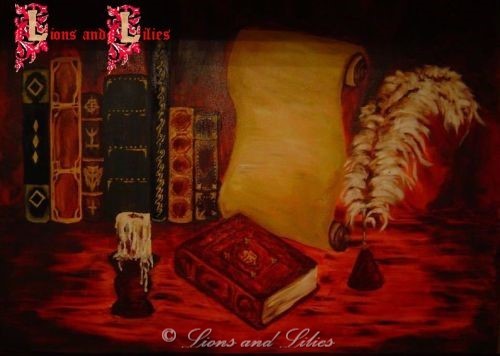
Cécile d’Armagnac—wistful, wayward and passionate—led the indulgent life of a French noble, never suspecting the family she adored was not her own.
Catherine Pembroke, a naive novice, abandoned at the Waif’s gate of a nunnery in England, had never known anything more than life behind the convent walls until she received a letter from a woman in France proclaiming to be her sister.
And just as these two women began to write to one another in the 14thcentury, in the modern world, Cathy A Wilson and Cathy T Wilson kept their relationship confined to emails only. They decided to not speak or meet until their characters did!


 Cathy A: We used that tool to enhance the manner in which we wrote. Catherine and Cécile communicate within ‘The Lily and the Lion,’ by way of letters. Cathy T and I did likewise, speaking only via email. I did not even know the sound of her voice! We were exactly as our characters were, all of us discovering, learning, and building a relationship with each other simply by way of the written word.
Cathy A: We used that tool to enhance the manner in which we wrote. Catherine and Cécile communicate within ‘The Lily and the Lion,’ by way of letters. Cathy T and I did likewise, speaking only via email. I did not even know the sound of her voice! We were exactly as our characters were, all of us discovering, learning, and building a relationship with each other simply by way of the written word. And it worked beautifully.
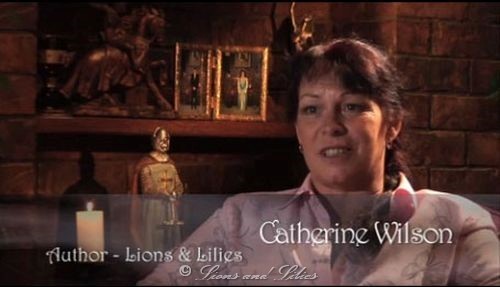
They wrote on for two and half books over a period of two years until eventually the occasion arose when it became necessary to discuss an offer on their first book. Unlike their troublesome counterparts who were thwarted at every turn to meet, Cathy A was able to pick up the phone and dial direct to Cathy T. Even though their sacred covenant had been broken, the first few minutes of conversation consisted of joyous laughter. Poor Catherine Pembroke and Cécile d’Armagnac would have to wait a bit longer.
In 2007 the women decided to finally meet and at the same time a Sydney video producer heard of their story. He decided to film this special meeting, capturing all the insecurities and excitement on film.
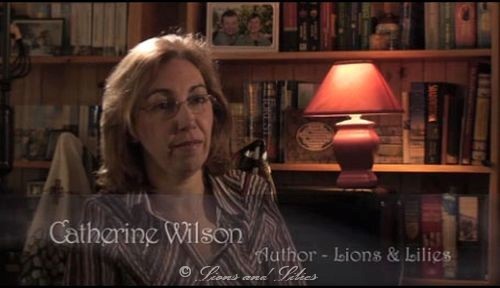
You may view the video here:-
And then, when a potential publisher suggested a change, Cathy A and Cathy T realised their 14th century counterparts should also be allowed the same joy of meeting one another.
The ‘Wilson women’ worked on, finally realising their dream of publication in 2012.

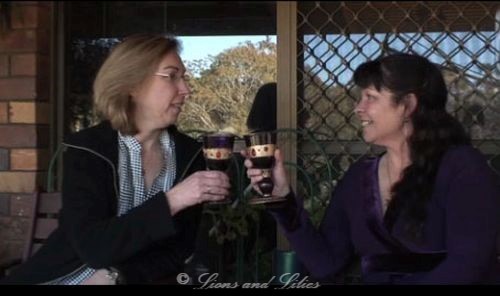
Rewrites and editing became daily chores and their characters definitely provided plenty of practise! The medieval sisters were hard to contain and often in perilous situations. But by now ‘this team’ had a regime that operated like clockwork, always allowing for the interference of ‘Madame Fate,’ which was often! Children were growing up, work schedules were changing and then changing again.
On Cathy T’s visits to New South Wales, she and Cathy A began to set up their own stall at medieval fairs where the books were warmly received.
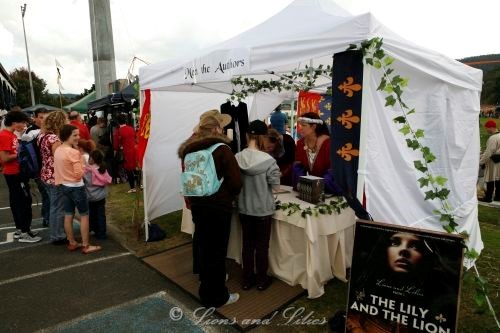
The release of ‘The Lily and the Lion’ – Ironfest 2012
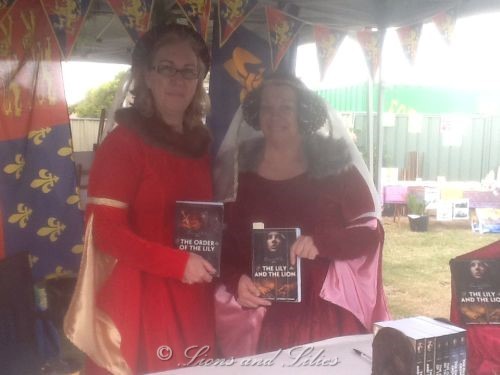
Ironfest 2015

Blacktown Medieval Faire in 2016
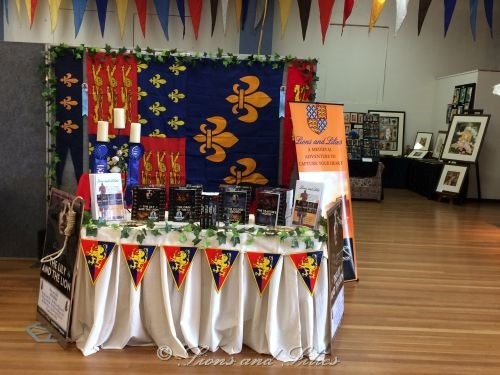
Ironfest 2017
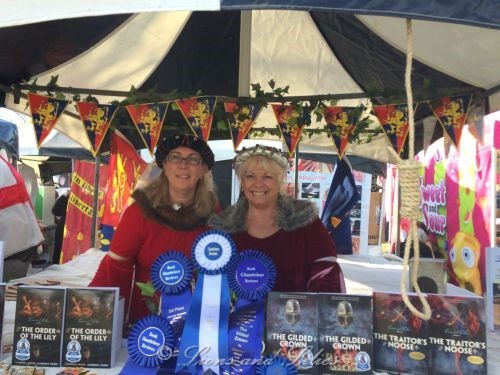
And over the years, they always made some time for fun!
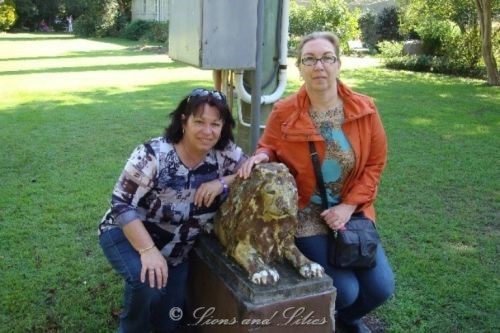

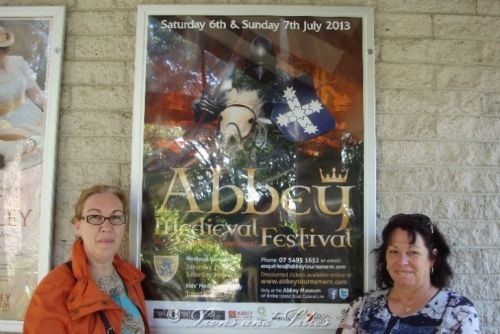
It was in 2013 that The Lily and the Lion won its first prize in Chanticleer’s ‘Chatelaine’ Award for Historical Romance. This was followed the next year by their second book, The Order of the Lily, winning the same category and then their third book, The Gilded Crown taking another first place in 2016.
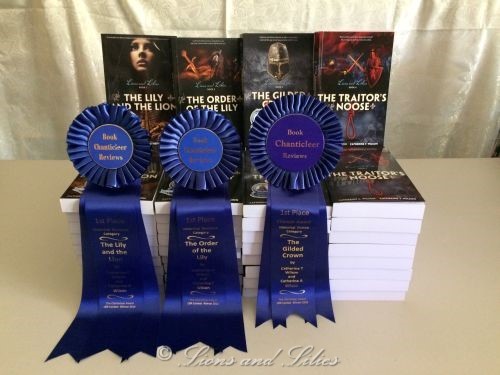
Earlier this year, The Traitor’s Noose won not only first prize in Chanticleer’s ‘Chaucer’ Award for ‘Historical Fiction’ but it took out the grand prize also.


They travelled to the US to receive their awards and attend a writing workshop weekend in Bellingham, north of Seattle, stopping in LA on the way home to visit the Hollywood Walk of Fame, have a coffee with ‘Friends,’ pose with some other friends, pick up an Oscar, and get their kicks on Route 66!
Hollywood Walk of Fame

Central Perk Café from the hit show ‘Friends’

Cathy A made friends with some super heroes
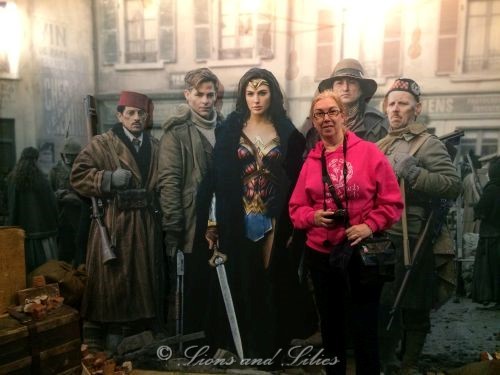
And they accepted their Oscar!
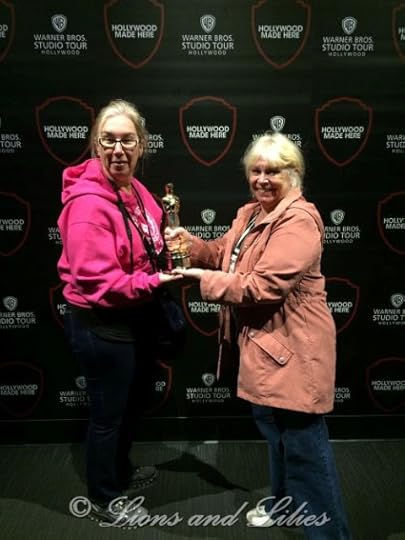
Get your kicks on Route 66! (Rolling Stones song)

Of course, they had to visit Medieval Times …

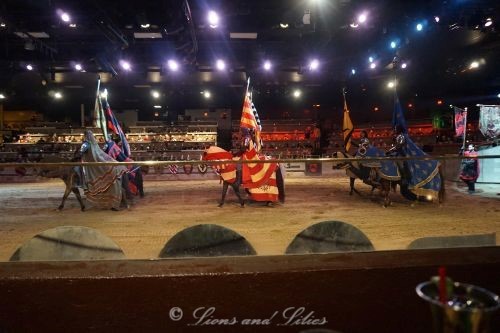
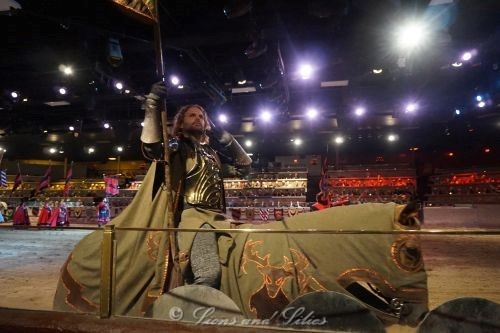

The two writers have since enjoyed many visits to each other, often accompanied by some marketing event or medieval faire,
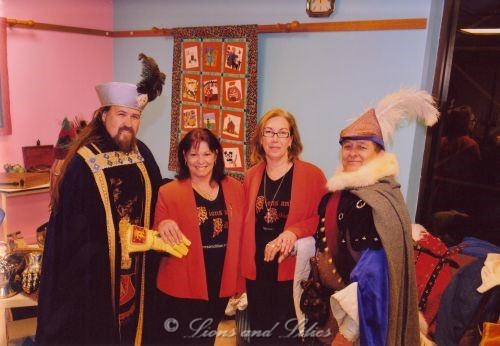
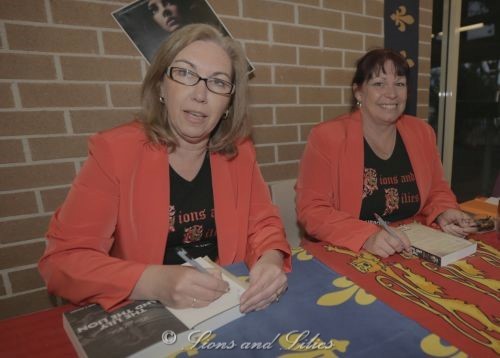
and the readership for Lions and Lilies continues to grow steadily.
 Cathy A: I have been told that in co-authoring, anything is fraught with danger; that writers are emotional beings who like to do things their own way. That might be the case for some, but it certainly is not for Cathy T and me.
Cathy A: I have been told that in co-authoring, anything is fraught with danger; that writers are emotional beings who like to do things their own way. That might be the case for some, but it certainly is not for Cathy T and me. Our biggest downfall? We talk too much! To each other, on the phone. Such is the strength of our relationship that I know I would not be the writer I am, if not for Cathy T.
The secret to our relationship and success – Honesty, Integrity, and Trust.

Cathy A and Cathy T are currently working on their fifth book, ‘Roar of the Lion,’ in the Lions and Lilies series. They hope it will be ready for release by December 2019.Narrative by Catherine T Wilson

The Lily and the Lion – Book One
In the war between England and France a medieval adventure begins with a letter. Two sisters, Cécile and Catherine, enter a world of passion and intrigue, separated as infants, rediscovered by chance. Can they unravel a mystery and be re-united?
The Order of the Lily – Book Two
A tale of powerful alliances, deadly plots and royal secrets. In an age when women held no power, Cécile and Catherine must rely on the courage of the knights who are assigned to protect them.
The Gilded Crown – Book Three
A dangerous power play between kingdoms, each must risk their life to foil a plot that could end the reign of one king and send another to war. In the darkest of hours, courage must be found.
The Traitor’s Noose – Book Four
What is worse than an unexpected betrayal? Discovering your darkest enemy lies within. When honour demands the ultimate sacrifice – loyalty, trust, love but you know, in the end, justice will be a traitor’s noose.
LINKS TO WHERE BOOKS CAN BE PURCHASED
http://bit.ly/1-TheLilyandtheLion
http://bit.ly/2-TheOrderoftheLily
http://bit.ly/3-TheGildedCrown
http://bit.ly/4-TheTraitorsNoose
Catherine A and Catherine T love to hear from readers, you can find them: Website • Facebook
Published on July 29, 2018 23:00
July 27, 2018
In the footsteps of Thomas Hardy by Mary Anne Yarde #amreading #ThomasHardy @nationaltrust
In the footsteps of Thomas Hardy By Mary Anne Yarde
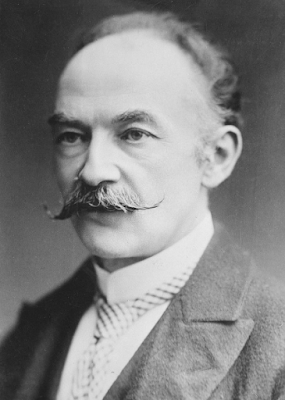
Can you remember when you first read a novel written by Thomas Hardy? I can. I was thirteen, and at the time the publishing house Penguin had started producing 99p Classics, here in the UK. Having no notion of who Thomas Hardy was I picked up a copy of Tess of the d'Urbervilles. Consequently, my love affair with Hardy's work began. By the age of 16 I had read all of Hardy's novels, and then I had the joy of studying his poetry at A'Level.
 Tess of the d'Ubervilles was first published in Britain in The Graphic, where it appeared in weekly instalments between July and November 1891
Tess of the d'Ubervilles was first published in Britain in The Graphic, where it appeared in weekly instalments between July and November 1891
Thomas Hardy was born in 1840 in Dorchester. His father, Thomas, was a stonemason and builder, his mother, Jemima , was well-read and taught Thomas his letters and continued his education until he was eight years old. By which time, Thomas was old enough to go to a school at Bockhampton. Later he went to Mr Last's Academy for Young Gentlemen in Dorchester. His teachers saw his potential, but unfortunately, the Hardy's were not in a position to send Thomas onto university.
 "Hardy's Cottage" This is where Hardy grew up. The house is now managed by The National Trust.
"Hardy's Cottage" This is where Hardy grew up. The house is now managed by The National Trust.
So instead, Thomas became an apprentice to a local architect, James Hicks. Thomas was a very gifted architect. He moved to London in 1862 and attended King's College. He won numerous prizes for his work, but London did not suit him. He missed the rolling hills of Dorset. He also became deeply distressed by what he witnessed. Social injustice was everywhere. He became very interested in social reform.
Thomas moved back to Dorset, and it was then that he decided to try his hand at some part-time writing.
Thomas's first book The Poor Man And The Lady failed to find a publisher. It had made for some uncomfortable reading and the world was not ready for Hardy’s take on social justice just yet. The next two books he published under a nom de plume. While working on Under A Greenwood Tree , Hardy met and fell in love with Emma Gifford. Hardy wrote about their courtship in A Pair Of Blue Eyes .
In 1874, Hardy release Far From The Madding Crowd. It was a great success. At last, Hardy could give up architectural work and pursue a literacy career. Two more books followed, and Hardy had enough money to design and build a house for him and his wife. He moved to Max Gate in 1885.
 Max Gate. The house is now managed by The National Trust.
Max Gate. The house is now managed by The National Trust.


Here he wrote some of his most significant works. Most notable Tess Of The d'Urbervilles.
 The study in which Hardy wrote Tess.
The study in which Hardy wrote Tess.
When Tess was published, Hardy faced a backlash from critics. The book was too scandalous. How can a fallen woman, a murderer, be a heroine of a story? Of course, it was an instant hit with Hardy's readers! And he became something of a celebrity, with eager fans waiting outside of his house to catch a glimpse of him. Hardy was a very private man, and he hated this attention. He planted trees around the perimeter of his house. He even designed and made some shutters that he could raise up and cover half the window in their dining room so he could eat in relative peace without a group of people nosing in through the windows.
 The garden at Max Gate
The garden at Max Gate
Hardy's success however, did not make for a happy home. Both Hardy and Emma were bitterly disappointed that they could not have a child. And as time wore on love turned to dislike. Hardy became fed up with Emma trying to take credit for his stories. Dislike turned to something very close to hate.
Hardy published Jude The Obscure in 1895. It did not go down well with his critics. Some bookshops sold Jude in a brown paper bag — so scandalous was it for the time. Bishop of Wakefield, Walsham How, burned his copy of the book. Hardy replied to this attack by saying:
"After these verdicts from the press, its next misfortune was to be burnt by a bishop – probably in his despair at not being able to burn me."
He only published one other book after this. It is argued that Hardy gave up writing after the criticism he received for both Tess and Jude.
In 1912 Emma became very ill with impacted gallstones. Emma's maid found her first thing in the morning in a state of great distress. Hardy was called, but by the time he got to his wife's chamber, Emma was unconscious. She died soon after. While going through her things, Hardy came across a book that Emma had written about her life. To start with her life was filled with passion and adventure but by the end, there was only bitterness and hate. Hardy was overcome with guilt at how his indifference had affected her. This guilt was something he never got over, even though he dedicated many hours in writing poetry about his Emma.
 The study where Hardy wrote his poetry.
The study where Hardy wrote his poetry.
 Hardy hated the small square window panes, but he could not afford two full side panes, so he had two medium size ones made. That way he could look out on the garden without the frames getting in his way!
Hardy hated the small square window panes, but he could not afford two full side panes, so he had two medium size ones made. That way he could look out on the garden without the frames getting in his way!
In 1914, Hardy married his secretary, Florence Emily Dugdale.
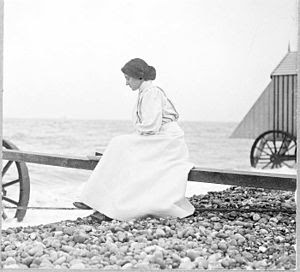 Florence Emily Dugdale
Florence Emily Dugdale
They had a happy marriage, although Emma's ghost was a constant companion to Hardy. They hosted many dinner parties, but for their guests, it could be a very traumatic affair. The Hardy's had a somewhat infamous dog called Wessex. Wessex had a bit of a temper problem. He was vicious, and the Hardy's did nothing to discipline him. Wessex was not only allowed to come into the dining room when they were eating, but he was allowed to sit on the table and growl, nip and bite anyone who annoyed him.
 The Hardy's dining table, set for afternoon tea.Unsurprisingly the Hardy's had some trouble keeping staff during Wessex's reign. For the dog was not choosey whom he bit.
The Hardy's dining table, set for afternoon tea.Unsurprisingly the Hardy's had some trouble keeping staff during Wessex's reign. For the dog was not choosey whom he bit.
 "The Famous Dog, Wessex — Faithfully Unflinching" Wessex's tombstone in the pet cemetery at Max Gate. Hardy died on 11th January 1921. His ashes were buried at Poets' Corner in Westminster Abbey, but his heart was laid to rest in the grave of his first wife, Emma.
"The Famous Dog, Wessex — Faithfully Unflinching" Wessex's tombstone in the pet cemetery at Max Gate. Hardy died on 11th January 1921. His ashes were buried at Poets' Corner in Westminster Abbey, but his heart was laid to rest in the grave of his first wife, Emma.

"I am the family face;Flesh perishes, I live on..."Heredity by Thomas Hardy
Mary Anne Yarde
 Mary Anne Yarde is the multi award-winning author of the International Bestselling Series — The Du Lac Chronicles. Set a generation after the fall of King Arthur, The Du Lac Chronicles takes you on a journey through Dark Age Briton and Brittany, where you will meet new friends and terrifying foes. Based on legends and historical fact, The Du Lac Chronicles is a series not to be missed.
Mary Anne Yarde is the multi award-winning author of the International Bestselling Series — The Du Lac Chronicles. Set a generation after the fall of King Arthur, The Du Lac Chronicles takes you on a journey through Dark Age Briton and Brittany, where you will meet new friends and terrifying foes. Based on legends and historical fact, The Du Lac Chronicles is a series not to be missed.
Born in Bath, England, Mary Anne Yarde grew up in the southwest of England, surrounded and influenced by centuries of history and mythology. Glastonbury — the fabled Isle of Avalon — was a mere fifteen-minute drive from her home, and tales of King Arthur and his knights were part of her childhood.
Mary Anne loves to hear from readers. You can find her: Website/Blog • Twitter • Facebook.

Can you remember when you first read a novel written by Thomas Hardy? I can. I was thirteen, and at the time the publishing house Penguin had started producing 99p Classics, here in the UK. Having no notion of who Thomas Hardy was I picked up a copy of Tess of the d'Urbervilles. Consequently, my love affair with Hardy's work began. By the age of 16 I had read all of Hardy's novels, and then I had the joy of studying his poetry at A'Level.
 Tess of the d'Ubervilles was first published in Britain in The Graphic, where it appeared in weekly instalments between July and November 1891
Tess of the d'Ubervilles was first published in Britain in The Graphic, where it appeared in weekly instalments between July and November 1891Thomas Hardy was born in 1840 in Dorchester. His father, Thomas, was a stonemason and builder, his mother, Jemima , was well-read and taught Thomas his letters and continued his education until he was eight years old. By which time, Thomas was old enough to go to a school at Bockhampton. Later he went to Mr Last's Academy for Young Gentlemen in Dorchester. His teachers saw his potential, but unfortunately, the Hardy's were not in a position to send Thomas onto university.
 "Hardy's Cottage" This is where Hardy grew up. The house is now managed by The National Trust.
"Hardy's Cottage" This is where Hardy grew up. The house is now managed by The National Trust.So instead, Thomas became an apprentice to a local architect, James Hicks. Thomas was a very gifted architect. He moved to London in 1862 and attended King's College. He won numerous prizes for his work, but London did not suit him. He missed the rolling hills of Dorset. He also became deeply distressed by what he witnessed. Social injustice was everywhere. He became very interested in social reform.
Thomas moved back to Dorset, and it was then that he decided to try his hand at some part-time writing.
Thomas's first book The Poor Man And The Lady failed to find a publisher. It had made for some uncomfortable reading and the world was not ready for Hardy’s take on social justice just yet. The next two books he published under a nom de plume. While working on Under A Greenwood Tree , Hardy met and fell in love with Emma Gifford. Hardy wrote about their courtship in A Pair Of Blue Eyes .
In 1874, Hardy release Far From The Madding Crowd. It was a great success. At last, Hardy could give up architectural work and pursue a literacy career. Two more books followed, and Hardy had enough money to design and build a house for him and his wife. He moved to Max Gate in 1885.
 Max Gate. The house is now managed by The National Trust.
Max Gate. The house is now managed by The National Trust.

Here he wrote some of his most significant works. Most notable Tess Of The d'Urbervilles.
 The study in which Hardy wrote Tess.
The study in which Hardy wrote Tess.When Tess was published, Hardy faced a backlash from critics. The book was too scandalous. How can a fallen woman, a murderer, be a heroine of a story? Of course, it was an instant hit with Hardy's readers! And he became something of a celebrity, with eager fans waiting outside of his house to catch a glimpse of him. Hardy was a very private man, and he hated this attention. He planted trees around the perimeter of his house. He even designed and made some shutters that he could raise up and cover half the window in their dining room so he could eat in relative peace without a group of people nosing in through the windows.
 The garden at Max Gate
The garden at Max GateHardy's success however, did not make for a happy home. Both Hardy and Emma were bitterly disappointed that they could not have a child. And as time wore on love turned to dislike. Hardy became fed up with Emma trying to take credit for his stories. Dislike turned to something very close to hate.
Hardy published Jude The Obscure in 1895. It did not go down well with his critics. Some bookshops sold Jude in a brown paper bag — so scandalous was it for the time. Bishop of Wakefield, Walsham How, burned his copy of the book. Hardy replied to this attack by saying:
"After these verdicts from the press, its next misfortune was to be burnt by a bishop – probably in his despair at not being able to burn me."
He only published one other book after this. It is argued that Hardy gave up writing after the criticism he received for both Tess and Jude.
In 1912 Emma became very ill with impacted gallstones. Emma's maid found her first thing in the morning in a state of great distress. Hardy was called, but by the time he got to his wife's chamber, Emma was unconscious. She died soon after. While going through her things, Hardy came across a book that Emma had written about her life. To start with her life was filled with passion and adventure but by the end, there was only bitterness and hate. Hardy was overcome with guilt at how his indifference had affected her. This guilt was something he never got over, even though he dedicated many hours in writing poetry about his Emma.
 The study where Hardy wrote his poetry.
The study where Hardy wrote his poetry.
 Hardy hated the small square window panes, but he could not afford two full side panes, so he had two medium size ones made. That way he could look out on the garden without the frames getting in his way!
Hardy hated the small square window panes, but he could not afford two full side panes, so he had two medium size ones made. That way he could look out on the garden without the frames getting in his way!In 1914, Hardy married his secretary, Florence Emily Dugdale.
 Florence Emily Dugdale
Florence Emily DugdaleThey had a happy marriage, although Emma's ghost was a constant companion to Hardy. They hosted many dinner parties, but for their guests, it could be a very traumatic affair. The Hardy's had a somewhat infamous dog called Wessex. Wessex had a bit of a temper problem. He was vicious, and the Hardy's did nothing to discipline him. Wessex was not only allowed to come into the dining room when they were eating, but he was allowed to sit on the table and growl, nip and bite anyone who annoyed him.
 The Hardy's dining table, set for afternoon tea.Unsurprisingly the Hardy's had some trouble keeping staff during Wessex's reign. For the dog was not choosey whom he bit.
The Hardy's dining table, set for afternoon tea.Unsurprisingly the Hardy's had some trouble keeping staff during Wessex's reign. For the dog was not choosey whom he bit.  "The Famous Dog, Wessex — Faithfully Unflinching" Wessex's tombstone in the pet cemetery at Max Gate. Hardy died on 11th January 1921. His ashes were buried at Poets' Corner in Westminster Abbey, but his heart was laid to rest in the grave of his first wife, Emma.
"The Famous Dog, Wessex — Faithfully Unflinching" Wessex's tombstone in the pet cemetery at Max Gate. Hardy died on 11th January 1921. His ashes were buried at Poets' Corner in Westminster Abbey, but his heart was laid to rest in the grave of his first wife, Emma.
"I am the family face;Flesh perishes, I live on..."Heredity by Thomas Hardy
Mary Anne Yarde
 Mary Anne Yarde is the multi award-winning author of the International Bestselling Series — The Du Lac Chronicles. Set a generation after the fall of King Arthur, The Du Lac Chronicles takes you on a journey through Dark Age Briton and Brittany, where you will meet new friends and terrifying foes. Based on legends and historical fact, The Du Lac Chronicles is a series not to be missed.
Mary Anne Yarde is the multi award-winning author of the International Bestselling Series — The Du Lac Chronicles. Set a generation after the fall of King Arthur, The Du Lac Chronicles takes you on a journey through Dark Age Briton and Brittany, where you will meet new friends and terrifying foes. Based on legends and historical fact, The Du Lac Chronicles is a series not to be missed.Born in Bath, England, Mary Anne Yarde grew up in the southwest of England, surrounded and influenced by centuries of history and mythology. Glastonbury — the fabled Isle of Avalon — was a mere fifteen-minute drive from her home, and tales of King Arthur and his knights were part of her childhood.
Mary Anne loves to hear from readers. You can find her: Website/Blog • Twitter • Facebook.
Published on July 27, 2018 00:30
July 25, 2018
Folklore of Cornwall — and the Ghost Hunter of Talland by Johanna Craven #Cornwall #Folklore #History @JohannaCraven
Folklore of Cornwall — and the Ghost Hunter of Talland.By Johanna Craven
Even today, Cornwall, on the southwest tip of England, is rugged, remote and isolated. It is a place of wild seas, sharp cliffs and moorland so far-flung you could believe you are the only person left on earth. The landscape is littered with stone circles and smugglers’ tunnels. Ghost stories abound. Life-like stone piskies watch around corner. It’s a place that makes it easy to believe in mystery and magic.

We can only imagine how this place must have felt in the eighteenth century; an era without trains or telephones in which I have chosen to set my latest book, Bridles Lane. At this time, the main road across Bodmin Moor, connecting Cornwall with the rest of the country was still a century away. Englishmen from other counties were known as ‘foreigners’, giving a sense of just how cut-off Cornwall was from the rest of the country.
The age of enlightenment was slow to reach superstitious Cornwall and in the 1700’s, the Cornish relied heavily on folk tales to make sense of their wild world. Boulders were remains of giants’ battles, the moors were populated by fairies and the sea was home to mermaids and monsters. A shipwreck would see a coast haunted for eternity. And if you listened carefully to the howling wind; you would hear the name of the next man to die.

The existence of ghosts and demons, of course, was undeniable. Both were things to be feared and both— if you asked the Cornish– ran rife through their villages. Enter Richard Dodge, vicar of the tiny village of Talland, and the county’s famous ghost hunter.
Known for his elaborate exorcisms in Bridles Lane outside his church, a superstitious population meant Dodge’s services were in high demand. A record of the vicar’s most famous “laying of the spirits” can be found today in the Talland Church archives. In 1725, Dodge received a letter from Mr Gryllis, rector at nearby Lanreath. His people, Gryllis claimed, were tormented by ghostly visions and he had come to Dodge for assistance. Together, Dodge and Gryllis ventured out to Blackadown Moor near the Fowey River. There— if the records are to be believed— the men encountered a ghostly carriage, driven by a headless horseman. Inside, Dodge claimed, rode the devil himself. But the vicar would not be defeated. He ordered the devil back to Hell and shrunk the ghostly carriage to the size of a mouse.
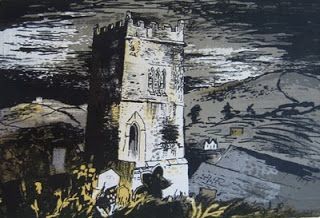 Talland Church. John Piper, 1944 www.pinterest.co.ukThrough modern eyes, we can see Dodge’s antics were a cover for the smuggling so prevalent in the area. Thanks to his tales of ghosts and demons, the main road through town would be empty by nightfall, leaving the path clear for the local smuggling gang to carry their contraband up from the beach and hide it safely in the church. But even with this knowledge, can we say for certain there was nothing to Dodge’s ghost stories? Walk the moors of Cornwall at night and you’ll find your mind wondering just what is hiding in the dark…
Talland Church. John Piper, 1944 www.pinterest.co.ukThrough modern eyes, we can see Dodge’s antics were a cover for the smuggling so prevalent in the area. Thanks to his tales of ghosts and demons, the main road through town would be empty by nightfall, leaving the path clear for the local smuggling gang to carry their contraband up from the beach and hide it safely in the church. But even with this knowledge, can we say for certain there was nothing to Dodge’s ghost stories? Walk the moors of Cornwall at night and you’ll find your mind wondering just what is hiding in the dark… Bridles Lane

Cornwall, England. 1740.
They say only the brave ride Bridles Lane at night.
Vicar Richard Dodge speaks of ghosts and demons, conducting elaborate exorcisms in his churchyard overlooking the lane. And with the villagers sheltering in fear, local smugglers carry their haul up the road to be hidden in the safety of the church.
Isaac and Scarlett Bailey have spent their lives hiding contraband in Talland church. Forced into free trade by their father's mistakes, they want nothing more than to escape the smuggling syndicate and build a life above the law.
On the other side of Bridles Lane, Flora Kelly has grown up in the shadow of her mother, the village charmer. Sceptical of her mother's craft, Flora reopens her family's tavern, determined that her life will not be one of fortune telling and herbal lore.
When a seemingly abandoned ship is wrecked in Talland Bay, it sparks a wave of hysteria among the superstitious villagers. Faith in the vicar wavers and Flora feels herself drawn to the controversial old ways of her mother. Among growing unrest, the mystery of the wrecked ship deepens, unearthing long-forgotten secrets that will tear a village- and a family- apart.
Inspired by true events, 'Bridles Lane' is the first book in the West Country Trilogy, from the author of 'Forgotten Places' and 'The Devil and the Deep Blue Sea'.
Amazon
Johanna Craven
 Johanna Craven is an historical fiction writer, pianist and film composer. She has lived on three continents and currently divides her time between London and Melbourne. She loves ghost-hunting, cooking (and eating) and plays the Celtic fiddle very badly.
Johanna Craven is an historical fiction writer, pianist and film composer. She has lived on three continents and currently divides her time between London and Melbourne. She loves ghost-hunting, cooking (and eating) and plays the Celtic fiddle very badly. Johanna released her first novel Music from Standing Waves in 2015 before signing with Endeavour Media for her second novel The Devil and the Deep Blue Sea. She is currently writing the West Country Trilogy, inspired by true events from 18thcentury Cornwall. Book One, Bridles Lane is available now.
Johanna loves to hear from readers, you can find her: Website• Facebook• Twitter • GoodReads.
Published on July 25, 2018 23:00
July 24, 2018
Author’s Inspiration ~ Paul Bennett #History #America #HistoricalFiction @hooverbkreview
Author’s Inspiration
Paul Bennett
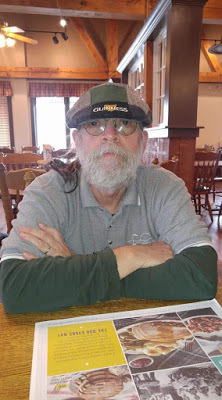 The inspiration to write was, in the beginning, merely to see if I could do it. I had written short pieces over the years but to tackle a full blown novel was a daunting prospect. Once the seed was planted I came up with a rough idea of telling the story of three siblings living somewhere in colonial America. Choosing that general locale was a natural fit for me as I’ve been a lifelong student of American history and I felt that if I was going to write a historical fiction novel, it might be prudent to choose a subject I knew a little about. I picked The French and Indian War as the starting point for what was now becoming a possible series of books that would follow the Mallory clan through the years. That war intrigued me and I saw a chance to tell the story through the eyes of the Mallory family. It also provided me with the opportunity to tell the plight of the Native Americans caught up in this conflict. The French and Indian War paved the way for the colonies to push further west into the Ohio River area. It also set the stage for the events of the 1770’s. Britain incurred a huge debt winning that war and looked to the colonies for reimbursement in the form of new taxes and tariffs. Well, we all know how those ungrateful colonists responded.
The inspiration to write was, in the beginning, merely to see if I could do it. I had written short pieces over the years but to tackle a full blown novel was a daunting prospect. Once the seed was planted I came up with a rough idea of telling the story of three siblings living somewhere in colonial America. Choosing that general locale was a natural fit for me as I’ve been a lifelong student of American history and I felt that if I was going to write a historical fiction novel, it might be prudent to choose a subject I knew a little about. I picked The French and Indian War as the starting point for what was now becoming a possible series of books that would follow the Mallory clan through the years. That war intrigued me and I saw a chance to tell the story through the eyes of the Mallory family. It also provided me with the opportunity to tell the plight of the Native Americans caught up in this conflict. The French and Indian War paved the way for the colonies to push further west into the Ohio River area. It also set the stage for the events of the 1770’s. Britain incurred a huge debt winning that war and looked to the colonies for reimbursement in the form of new taxes and tariffs. Well, we all know how those ungrateful colonists responded.
An inspiration for the last couple of chapters in Clash came about because I grew up in Detroit, MI. the site of Pontiac’s Rebellion. When France lost, the tribes that sided with them found themselves under the thumb of the British, a situation that became intolerable due to the harsh methods of Jeffrey Amherst. A coalition of tribes arose under the Ottawa chief Pontiac so even though the war was over, conflict continued. That was too good a setting to ignore so I made sure my protagonists were part of the action.
As to the name Mallory – I have a photo hanging on my living room wall of my great grandfather, Harry Mallory. I got to know him when I was a young boy and was always glad when we visited him. He lived a good portion of his life in western Pennsylvania which is where much of Clash of Empires takes place. So, as a gesture to my forebears, Mallory became the name of the family.
One thing I have learned while writing Clash is that the characters I created, that I gave life to, often have minds of their own. I’ll have an idea where I want a particular passage, scene, or conversation to go, but when I start writing that bit something happens. It’s as if my characters have hijacked my fingers and voilà, a new idea is born. I suspect that this activity on the part of my characters is part of a conspiracy concocted and led by my feisty Muse. She seems to delight in surprising me, often while I am driving to and from work. One day I spied a bald eagle flying overhead as I was passing Minuteman National Park, the site of the famous battle of Lexington and Concord that began the Revolutionary War. I know that was my Muse in the guise of an eagle, scouting out the area for the chapter I was soon to write about that battle.
Clash Of EmpiresA Novel Of The French & Indian Wars

Thomas and Abigail Mallory move their family from their farm on the Susquehanna River to a frontier trading post near Fort Duquesne (modern day Pittsburgh) at a time when the French and the British both seek to control the lucrative fur trade along the Ohio River. Clash of Empires is the story of the Mallory family as they are caught up in the conflict that would become The French and Indian War. It is a tale of the three Mallory siblings, Daniel. Liza and Liam and their involvement in the conflict; the emotional trauma of lost loved ones, the bravery they exhibit in battle situations; the friendships they develop with the young, first time militia commander George Washington, and the friends, or enemies, made with many of the Native American tribes caught up the war. Clash of Empires is the first book in The Mallory Saga, a saga that will follow the Mallory clan through the making of the United States, and its rise to power in the 19th century.
Amazon US • Amazon UK
Paul Bennett
 Paul’s education was of the public variety and when he reached Junior High he discovered that his future did not include the fields of mathematics or science. This was generally the case throughout his years in school as he focused more on his interest in history; not just the rote version of names and dates but the causes.Paul studied Classical Civilization at Wayne State University with a smattering of Physical Anthropology thrown in for good measure. Logically, of course, Paul spent the next four decades drawing upon that vast store of knowledge working in large, multi-platform data centers, and is considered in the industry as a bona fide IBM Mainframe dinosaur heading for extinction.Paul currently resides in the quaint New England town of Salem, Massachusetts with his wife, Daryl. The three children have all grown, in the process turning Paul’s beard gray, and have now provided four grandchildren; the author is now going bald.Paul loves to hear from readers, you can find him: Blog Twitter
Paul’s education was of the public variety and when he reached Junior High he discovered that his future did not include the fields of mathematics or science. This was generally the case throughout his years in school as he focused more on his interest in history; not just the rote version of names and dates but the causes.Paul studied Classical Civilization at Wayne State University with a smattering of Physical Anthropology thrown in for good measure. Logically, of course, Paul spent the next four decades drawing upon that vast store of knowledge working in large, multi-platform data centers, and is considered in the industry as a bona fide IBM Mainframe dinosaur heading for extinction.Paul currently resides in the quaint New England town of Salem, Massachusetts with his wife, Daryl. The three children have all grown, in the process turning Paul’s beard gray, and have now provided four grandchildren; the author is now going bald.Paul loves to hear from readers, you can find him: Blog Twitter
Paul Bennett
 The inspiration to write was, in the beginning, merely to see if I could do it. I had written short pieces over the years but to tackle a full blown novel was a daunting prospect. Once the seed was planted I came up with a rough idea of telling the story of three siblings living somewhere in colonial America. Choosing that general locale was a natural fit for me as I’ve been a lifelong student of American history and I felt that if I was going to write a historical fiction novel, it might be prudent to choose a subject I knew a little about. I picked The French and Indian War as the starting point for what was now becoming a possible series of books that would follow the Mallory clan through the years. That war intrigued me and I saw a chance to tell the story through the eyes of the Mallory family. It also provided me with the opportunity to tell the plight of the Native Americans caught up in this conflict. The French and Indian War paved the way for the colonies to push further west into the Ohio River area. It also set the stage for the events of the 1770’s. Britain incurred a huge debt winning that war and looked to the colonies for reimbursement in the form of new taxes and tariffs. Well, we all know how those ungrateful colonists responded.
The inspiration to write was, in the beginning, merely to see if I could do it. I had written short pieces over the years but to tackle a full blown novel was a daunting prospect. Once the seed was planted I came up with a rough idea of telling the story of three siblings living somewhere in colonial America. Choosing that general locale was a natural fit for me as I’ve been a lifelong student of American history and I felt that if I was going to write a historical fiction novel, it might be prudent to choose a subject I knew a little about. I picked The French and Indian War as the starting point for what was now becoming a possible series of books that would follow the Mallory clan through the years. That war intrigued me and I saw a chance to tell the story through the eyes of the Mallory family. It also provided me with the opportunity to tell the plight of the Native Americans caught up in this conflict. The French and Indian War paved the way for the colonies to push further west into the Ohio River area. It also set the stage for the events of the 1770’s. Britain incurred a huge debt winning that war and looked to the colonies for reimbursement in the form of new taxes and tariffs. Well, we all know how those ungrateful colonists responded. An inspiration for the last couple of chapters in Clash came about because I grew up in Detroit, MI. the site of Pontiac’s Rebellion. When France lost, the tribes that sided with them found themselves under the thumb of the British, a situation that became intolerable due to the harsh methods of Jeffrey Amherst. A coalition of tribes arose under the Ottawa chief Pontiac so even though the war was over, conflict continued. That was too good a setting to ignore so I made sure my protagonists were part of the action.
As to the name Mallory – I have a photo hanging on my living room wall of my great grandfather, Harry Mallory. I got to know him when I was a young boy and was always glad when we visited him. He lived a good portion of his life in western Pennsylvania which is where much of Clash of Empires takes place. So, as a gesture to my forebears, Mallory became the name of the family.
One thing I have learned while writing Clash is that the characters I created, that I gave life to, often have minds of their own. I’ll have an idea where I want a particular passage, scene, or conversation to go, but when I start writing that bit something happens. It’s as if my characters have hijacked my fingers and voilà, a new idea is born. I suspect that this activity on the part of my characters is part of a conspiracy concocted and led by my feisty Muse. She seems to delight in surprising me, often while I am driving to and from work. One day I spied a bald eagle flying overhead as I was passing Minuteman National Park, the site of the famous battle of Lexington and Concord that began the Revolutionary War. I know that was my Muse in the guise of an eagle, scouting out the area for the chapter I was soon to write about that battle.
Clash Of EmpiresA Novel Of The French & Indian Wars

Thomas and Abigail Mallory move their family from their farm on the Susquehanna River to a frontier trading post near Fort Duquesne (modern day Pittsburgh) at a time when the French and the British both seek to control the lucrative fur trade along the Ohio River. Clash of Empires is the story of the Mallory family as they are caught up in the conflict that would become The French and Indian War. It is a tale of the three Mallory siblings, Daniel. Liza and Liam and their involvement in the conflict; the emotional trauma of lost loved ones, the bravery they exhibit in battle situations; the friendships they develop with the young, first time militia commander George Washington, and the friends, or enemies, made with many of the Native American tribes caught up the war. Clash of Empires is the first book in The Mallory Saga, a saga that will follow the Mallory clan through the making of the United States, and its rise to power in the 19th century.
Amazon US • Amazon UK
Paul Bennett
 Paul’s education was of the public variety and when he reached Junior High he discovered that his future did not include the fields of mathematics or science. This was generally the case throughout his years in school as he focused more on his interest in history; not just the rote version of names and dates but the causes.Paul studied Classical Civilization at Wayne State University with a smattering of Physical Anthropology thrown in for good measure. Logically, of course, Paul spent the next four decades drawing upon that vast store of knowledge working in large, multi-platform data centers, and is considered in the industry as a bona fide IBM Mainframe dinosaur heading for extinction.Paul currently resides in the quaint New England town of Salem, Massachusetts with his wife, Daryl. The three children have all grown, in the process turning Paul’s beard gray, and have now provided four grandchildren; the author is now going bald.Paul loves to hear from readers, you can find him: Blog Twitter
Paul’s education was of the public variety and when he reached Junior High he discovered that his future did not include the fields of mathematics or science. This was generally the case throughout his years in school as he focused more on his interest in history; not just the rote version of names and dates but the causes.Paul studied Classical Civilization at Wayne State University with a smattering of Physical Anthropology thrown in for good measure. Logically, of course, Paul spent the next four decades drawing upon that vast store of knowledge working in large, multi-platform data centers, and is considered in the industry as a bona fide IBM Mainframe dinosaur heading for extinction.Paul currently resides in the quaint New England town of Salem, Massachusetts with his wife, Daryl. The three children have all grown, in the process turning Paul’s beard gray, and have now provided four grandchildren; the author is now going bald.Paul loves to hear from readers, you can find him: Blog Twitter
Published on July 24, 2018 23:00
July 23, 2018
Blog Tour and #Giveaway ~ Last Dance in Kabul By Ken Czech #HFVBTBlogTours #HistoricalFiction @hfvbt
Historical Fiction Virtual Book Tours presents….

Last Dance in KabulBy Ken Czech

The Ultimate Dance Between Love and War
When his superiors ignore his warnings of an impending Afghan insurrection in 1841, British army captain Reeve Waterton vows never to return to Kabul. But then he rescues strong-willed Sarah Kane from an ambush and his plans for civilian life and self-preservation unravel around him.
At first Reeve dislikes Sarah as much as she loathes him. She’s as impudent and disdainful of authority as he, plus she’s betrothed to his bitterest rival.
It’s only after Reeve’s closest friend is brutally murdered and the Afghan tribes explode in revolt that he and Sarah discover their desperate need for each other. When the retreating British army is caught between the jaws of Afghanistan’s blizzard-wracked mountain passes and hordes of vengeful tribesmen, Sarah and Reeve must rely on their skills, courage, and blossoming love just to survive.
“You won’t find two more compelling characters than Reeve Waterton and Sarah Kane. I love them. I rooted for them to survive and work things out from the third chapter until the exciting conclusion. Their story was so expertly woven between survival and romance that I found it difficult to pull myself away from it.” Ray Simmons, for Reader’s Favorite
AMAZON | BARNES AND NOBLE | INDIEBOUND
Giveaway
During the Blog Tour we will be giving away a paperback copy of Last Dance in Kabul! You can enter HERE!
Giveaway Rules
• Giveaway ends at 11:59pm EST on July 31st. You must be 18 or older to enter.• Giveaway is open to US residents only.• Only one entry per household.• All giveaway entrants agree to be honest and not cheat the systems; any suspect of fraud is decided upon by blog/site owner and the sponsor, and entrants may be disqualified at our discretion.• Winner has 48 hours to claim prize or new winner is chosen.
Dr. Ken Czech
 Dr. Ken Czech is a retired history professor and an internationally recognized authority on the historical literature of exploration and sport. His passion, however, has turned to writing fiction. He and his wife Mary live in Central Minnesota on an abandoned granite quarry.
Dr. Ken Czech is a retired history professor and an internationally recognized authority on the historical literature of exploration and sport. His passion, however, has turned to writing fiction. He and his wife Mary live in Central Minnesota on an abandoned granite quarry.For more information, please visit Ken’s website. You can also find him on Facebook, Amazon and Goodreads.
Published on July 23, 2018 23:00
July 22, 2018
#BookReview ~ Innocent Indiscretions (Unrivalled Regency Book 7) By Jackie Williams #Regency #Romance @wackyjackyful
Innocent Indiscretions (Unrivalled Regency Book 7)By Jackie Williams
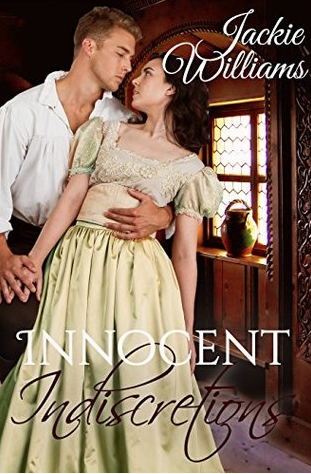
Can a gentle kiss beneath the mistletoe seal your fate? Especially when given by the deliciously handsome but ostracized, Lord Jeremy Rookwood.
Probably not.
But a kiss is a kiss, even if meant in innocence. And an indiscretion seen in public can only lead to disaster, destruction, and desolation. Especially when Elisa Rowallan’s newly announced fiancé is not the giver of the kiss, but an evil, money grabbing murderer with only one object in mind. Her!
Five years after first meeting one fateful night, Jeremy is still smitten and Elisa clearly in love, but desperation turns their happiness into instant despair. With her life in peril, and danger lurking behind every shadow, has Jeremy’s innocent indiscretion sealed Elisa’s fate, or can they outrun the malevolence that pursues them into a frosty night?
Innocent Indiscretions is the 7th book in the Unrivalled Regency series of Regency mystery romance. While each book is a standalone story, the series is best read in order due to the reappearance of previous characters and places. The book is suitable for anyone age 16+ due to some sensual scenes and adult language.
The Coffee Pot Book Club Review

If it wasn’t for Jeremy, goodness knows where Elisa Rowallan would have ended up. She had a lot to thank him and his friends for. However, it was more than thanks she felt for Jeremy. Unfortunately, it has been five long years since last she had seen him. She could only conclude that her feelings for him had not been returned.
For five years, Jeremy had kept his distance, but he cannot stay away from Elisa any longer. She is the love of his life, and by the look in her eyes, he dares to hope that he is the love of hers. However, dark and dangerous forces plot against both Elisa and Jeremy. They must keep their wits or risk losing each other forever.
I was so excited when I heard that there was another book in the Unrivalled Regency series, and I could not wait to get my hands on it. Innocent Indiscretions (Unrivalled Regency Book 7) by Jackie Williams was everything I hoped it would be and then some. Mis Williams brought the glamour of the Regency era to life, and, as with all her books, I fell into the story.
I adored the characterisation of both Elisa and Jeremy. Their romance is so sweet, and their love was very believable and real in the telling. The story itself was filled with many twists and turns. I feared for our brave protagonists lives at one point. This story certainly kept me on the edge of my seat!
If you are looking for a sweet Regency Romance with a fast-paced plot with plenty of action, then look no further than Innocent Indiscretions. This book is part of a series, but it stands very well on its own. However, I do recommend picking up the other books in the series as well because they are fabulous!
I Highly Recommend.
Jackie Williams
 I was born in Essex England during the mid sixties but I missed all the fun. Being only young, I assumed that all Beatles were six legged creatures and Flower Power was something to do with the vigorous way my mother kneaded the bread dough.
I was born in Essex England during the mid sixties but I missed all the fun. Being only young, I assumed that all Beatles were six legged creatures and Flower Power was something to do with the vigorous way my mother kneaded the bread dough.My wonderful parents brought me up with a huge love of books. We read anything and everything. Bedtime stories were a treasured time of adventure and mystery. My sister and I sat wide eyed in wonder and to this day I worry about Dinah and Dorinda being pricked with pins because they grew so fat, and I never pull faces at the a waning moon (or was it a waxing one?) just in case my chops stay that way . (The Wind On The Moon)
I began reading romance while still at school. The fuel for many a teenage fantasy leapt from between the covers of wildly romantic books and my passion still lingers now for all those dark haired heroes.
My own beautiful teenage daughter persuaded me to write my first romance. She was only fourteen at the time and between books for children and adults. She couldn't find anything that ticked all her numerous and particular boxes and so she asked me to write a book, with all the exact ingredients just for her. Though not just a book for teens, she enjoyed the resulting tale so much that she shared it with her friends and I eventually published A Perfect Summer as an ebook on amazon.
But I have discovered that writing is not easily stopped once you start. It has turned into a grand passion that I just cannot hold back. The fingertips start tapping the keys and ideas suddenly come flooding, far too many for just one book and so I began another and then another, and I am still nowhere near done.
I hope you enjoy all of my efforts and I look forward to your comments and reviews.
If you are interested in finding out more, you can see what I get up to at:
Romance Suspense Books
Don’t forget to sign up to my newsletter for all my latest goings on:
Newsletter
You can find me on Wordpress, Twitter, Facebook, Google+, Pinterest, and Instagram.
Published on July 22, 2018 23:00
July 19, 2018
The Quandary of Public Domain Photos by Mercedes Rochelle #amwriting #HistoricalFiction @authorrochelle
The Quandary of Public Domain PhotosBy Mercedes Rochelle

I could just about guarantee that I'm not the only underpaid indie author who has wondered about using a public domain photo on the cover of their new novel. Well, I finally decided to push this question to its logical conclusion, and I thought I'd share the process with you. I am not a lawyer, so don't take me at my word! But I have at least one experience to pass on.
For me, the picture in question was from a manuscript in the British Library. The image is all over the Internet and, most importantly, on Wikipedia, a kind of the clearinghouse for public domain images, as I see it. For the record, Wikipedia tells us "the copyright term is the author's life plus 70 years or less." Since I am using a manuscript illumination, that's not a problem. I knew I could use these pictures on the Internet: a blog post, social media, and my webpage. But when it comes to something like a book, I knew somehow that the rules were different. First of all, copyright laws tend to cover the country of origin. Even if I could use it in the United States, what about Europe? I wouldn't (or couldn't) limit my distribution to just one country.
So I went to the British Library site (https://imagesonline.bl.uk/) where you can purchase a license. That was the easy part. Below the image you can click on an icon to determine the price. First they ask you a question: is this for personal use, advertising, editorial, or products? For personal use, the price is £7.50, for advertising the price is £691.20. I'm already confused, because if I take the image from Wikipedia for my personal use, it doesn't cost anything.
Which category does my book cover fall into? I'm not a publisher or a business, so my book is being published personally. Isn't it? What is the definition of advertising? Do they mean a picture on a coffee cup or a magazine advertisement, or something of that ilk? Is a book cover considered advertising? When I checked out the Terms and Conditions, it tells us, "Reproduction (allowed): includes any form of publication or copying of the whole or part of any Image whether altered or not, and derived from any Image whether by printing, photography, slide projection, xerography, artists' reference, artists' illustration, layout or presentation, electronic or mechanical reproduction or storage by any other means." OK, my book is covered by "any form of publication", I suppose.
So, taking this as permission, I paid my £7.50 and proceeded to fret about it for a couple of days. Finally, just to be sure, I sent an email to the support people and gave them a working copy of my cover with an explanation. They were very responsive. The next day I received an answer, telling me, "The licence you have purchased is only for personal use. Please let us know the print run and language territory rights required for your book. For front cover use the fee is much higher but we would deduct or refund the fee you have paid." Well, that was that. Expecting the worst, I explained to them that my book was Print on Demand and I had no way of knowing how many were going to sell; it could be 10, or 100, or 500. I was already prepared to scrap the whole idea, having resigned myself to the worst. Imagine my surprise the next day to hear from them again: "The permission fee will be an additional £46.45." That's a far cry from £691 and change! Needless to say, I jumped on it (and printed a copy of the email for my records). And now I am the happy licensee of a public domain image that assuredly was inaccessible before the days of the Internet.
I have absolutely no idea how they arrived at a price. What I did learn is that in this new world, it behoves us not to assume anything. Had I not written that letter, I might have gotten myself into a lot of trouble. On the other hand, my image of choice was not out of reach after all.
A King Under Siege: Part 1 of The Plantagenet Legacy

Richard II’s reign was difficult from the start. Crowned king at age ten, he was only fourteen when the Peasants’ Revolt terrorized London. But he proved himself every bit the Plantagenet successor, facing Wat Tyler and the rebels when all seemed lost. Alas, his triumph was short-lived, and for the next ten years he struggled to assert himself against his uncles and increasingly hostile nobles. Just like in the days of his great-grandfather Edward II, vengeful magnates strove to separate him from his friends and advisors and even threatened to depose him if he refused to do their bidding. The Lords Appellant, as they came to be known, launched a devastating campaign against Richard’s supporters, bending Parliament to their will and removing everyone he depended on except for his queen. The unimportant ones were dismissed; the scapegoats fled the country to permanent exile. And the brave ones who remained were eliminated by judicial murder. The king's wishes were disregarded and the victors reduced Richard II to a figurehead. But not for long. The Merciless Parliament marked the end of Richard’s youth and changed his viewpoint forever. He would never forget his humiliation at the hands of his persecutors.
Coming soon…
Excerpt
Ten thousand or more crowded the banks of the Thames near the king's manor of Rotherhithe, shrieking and howling like the demons of hell. The royal barge, hung with the Plantagenet lions, floated safely in the middle of the river, while King Richard gripped his sword hilt, trying to emulate his forefathers. Tall for his age, of delicate features and red hair, the fourteen year-old monarch looked every bit the Plantagenet successor—though right now he felt more frightened than brave.
He waited for them to quiet down. "Why are you here and what do you want?"
The young voice, clear and shrill, reached its listeners who broke out once again into a clamor, shaking their farm tools and rusty old swords.
"Come to the shore!" they demanded. "Speak with us in person!"
Standing under a large red canopy among the few supporters brave enough to accompany him, Richard glanced upriver at the four smaller barges loaded with courtiers. The boats had hung back, not daring to come any closer. This was a sorry plight they had gotten themselves into!
Sighing, Richard turned to Archbishop Sudbury. He could see the terror in the prelate's face."I promised I would speak with them," the king said uncertainly. "I must at least try."
Bristling under two great banners with St. George's cross and forty pennons, the mob continued its uproar while the king turned to his other advisors. Sir Robert Hales, England's treasurer, stepped up beside the Archbishop.
"We cannot expect any mercy from them. They are out for blood." His eyes were almost bulging from his head.
Richard then turned to the earl of Salisbury, the most experienced soldier on the barge. "And what is your advice?" he asked, trying to keep a brave face.
"You cannot go ashore. They might restrain you—hold you hostage, or worse. This is an undisciplined rabble."
Biting his lip, Richard turned back to the crowd. "What is it you want from me?" he shouted. "Tell me, now that I have come this far."
He stood, arms crossed, while the men closest to the river conferred with each other. Finally, coming to a decision, the apparent leader got into a boat with a couple of rowers. They brought their craft as close as they dared. "Here is what we want," the man called. "We demand the heads of John of Gaunt, Archbishop Sudbury, Treasurer Hales, Sir John Fordame Clerk of the Privy Seal, Chief Justice Robert Belknap, Ranulf Ferrers, Robert Plesington Baron of the Exchecker, John Legge and Thomas Brampton."
"Why, you seek to deprive me of my chief ministers," Richard cried while Sudbury called down God's curses on their heads.
"We seek to save you from corrupt officials," the rebel shouted back.
"This is too dangerous," Salisbury spoke in Richard's ear. "We must leave this rabble."
Nodding in agreement, the king tried one last time. "If you wish to continue negotiations," he called, less sure of himself, "you may do so at Windsor on Monday next." While he was speaking, the barge was already turning around. Stunned at losing their advantage, the crowd howled in anger and the rebel boat fell back in confusion. But Richard no longer cared. He was headed for the safety of the Tower, though for the first few minutes they were at the mercy of any archer who might choose to draw his bow. But nothing happened aside from the shouts of "Treason! Treason!" that diminished as they gained speed. The king stared at the receding mob, biting his lip, until they were out of range. No one had turned his arrow against the royal barge. Perhaps there was some discipline left after all.
Mercedes Rochelle
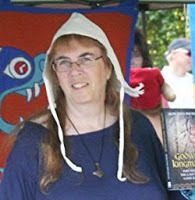 Born in St. Louis MO with a degree from University of Missouri, Mercedes Rochelle learned about living history as a re-enactor and has been enamored with historical fiction ever since. A move to New York to do research and two careers ensued, but writing fiction remains her primary vocation. She lives in Sergeantsville, NJ with her husband in a log home they had built themselves.
Born in St. Louis MO with a degree from University of Missouri, Mercedes Rochelle learned about living history as a re-enactor and has been enamored with historical fiction ever since. A move to New York to do research and two careers ensued, but writing fiction remains her primary vocation. She lives in Sergeantsville, NJ with her husband in a log home they had built themselves.Mercedes loves to hear from readers. You can find her… WebsiteBlog Facebook Twitter
Published on July 19, 2018 23:00
July 18, 2018
Glass Island - The Fictional World of 6th Century Britain by Gareth Griffith #amwriting #HistoricalFiction @garethgriffith_
Glass Island - The Fictional World of 6th Century BritainBy Gareth Griffith

Glass Island, my novel set in 6th century Britain, specifically in the years AD 576-578, tells of the westward push of the Saxons into what is now south- west England and of the resistance of the native population. The story is told from the side of the Celtic Britons, taking a young woman, a chieftain’s daughter by the name of Eleri Gwir (Eleri the Truth or Plain Speaker) as its central character. The major turning point is a battle recorded in the Anglo-Saxon Chronicle as the Battle of Deorhem (Dyrham) of 577 and it is this event that forms the dramatic centrepiece of the novel. It is thought to be a decisive moment in British history, an event that broke the land bridge between the Celts of Wales and those in Devon and Cornwall. It may also have resulted in a wave of Britons migrating to what later became known as Brittany. In writing of “The Fictional World of 6th Century Britain,” I wish to convey some of the difficulties that novelists and historians alike encounter in this period of history about which very little is known. All the “historical facts” in the previous paragraph could well turn out to be unfounded. There may not have been a Battle at Deorhem at all. If there was, it may not have been in 577. And what are we to make of the claim that the three British “kings” of Bath, Cirencester and Gloucester died there? The evidence is sparse, confined to a single line in the Anglo-Saxon Chronicle recording what may by then have been more folk memory than hard fact. The same goes for the emigration theory, which is speculative. Certainly, the Britons migrated to Brittany – but did the Battle of Deorhem result in one such migration? We don’t know for sure. Personally, I knew next to nothing of this history until I happened, by chance, to come across a book in a library. This was an academic treatise by Professor Kenneth Jackson called Language and History in Early Britain , published in 1953 by the Edinburgh University Press. It was one of those moments. Standing at the bookshelf, I started writing the first chapter of Glass Island in my head. Since then I have come to realise that Jackson’s work was a ground-breaking book for its time and remains to this day a reference point for scholars in the field. Basically, in his historical overview Jackson follows the schema set out in the Anglo-Saxon Chronicle, whereby the West Saxons started a new advance in the last quarter of the 6th century, beginning at Old Sarum and Barbury and culminating in the battle at Deorhem. Jackson wrote: “By this the bounds of Wessex were pushed up to the Severn along a broad front from northern Somerset to the country already occupied on the Warwickshire Avon; and the Severn was still apparently regarded as the boundary between English and Welsh at the time of Augustine’s conference with the British bishops in 603. Thus practically the whole of Gloucestershire east of the Severn was now part of Wessex, and the Welsh of Wales were divided by land from the Britons of the South- West.” (Jackson, p 204)Assuming that to have been the case, what issues arise for the novelist, in particular for one writing from the losing side in this struggle? For a start, the story becomes one of loss and dispossession for those Britons living in the region we now identify with the county of Somerset, an area that encompasses modern-day Bath, Glastonbury and Taunton. Who were these people? How did they live? What did they believe? What stories did they tell themselves about their lives, past, present and future? Did they flee from their enemies after the decisive battle was lost, or did they stay to serve their new masters?The Laws of Ine, which relate to a West Saxon king of 690, suggest that “Welshmen” continued to live in some parts of Wessex at that time, although at a lower social standing than their Saxon neighbours. Indeed, Nicholas J Higham has compared that “racially defined legal system” with Apartheid in late twentieth-century South Africa, with such a system leading eventually to the Britons losing their assets. (The Anglo-Saxon World edited by Nicholas J Higham and Martin J Ryan, Yale University Press, 2015, p 110) For Jackson, meanwhile, it seemed plausible that Brittonic was still spoken in parts of Somerset and Dorset in this later period, but not in what he terms “the old, eastern Wessex.” (Jackson, p 239) Even if some or even many Britons remained, we yet come to a time when one way of life ended and another started, with the old way almost entirely lost to history. It is a universal theme, dealing with what happens to people who find themselves on the wrong side of history, as refugees, as slaves, their names and their identities forgotten. Because little or no record is left, written or archaeological, it’s as if they never existed. They are left to be recovered by the novelist.
This issue is taken up at the very end of the novel, in “Last Words”, where the narrator (Owain) speaks years later to the central character (Eleri Gwir), as follows: “Write it down, Owain,” she said. “Before we’re all dead and gone.” “Why?” I asked. “Because if we are to live on, if we are to be remembered, the land and its people, our story must be known,” Eleri said. “If we don’t make our mark on the page, we’ll be lost to history. No one will know we ever lived and breathed. We’ll melt away and we’ll be gone forever, carried off by the river of time.” ‘Bryn Derwydd won’t be forgotten,” I insisted. ‘It will if a record isn’t made. It has to be worth remembering to someone, Owain. Our story has to be worth remembering. If we don’t tell it, who will? Will our enemies? I don’t think so. They’ll tell their own side of it, if they say anything at all.” There is obvious irony in writing a novel about the losing side (the Britons) in the language of the winners (English). In seeking to retain a sense of that native cultural tradition and to convey the foreignness and otherness of the Britons to the Saxons, I have inserted a smattering of non-English names and phrases. For example, I do not refer to the Battle of Deorhem, which is what the Saxons called it, but to the Battle of Bryn Derwydd (as it happens, the name of the hill behind my grandmother’s house in Penmaenmawr, North Wales). In doing so, I am paying a debt to another book which has influenced Glass Island – Robert Graves’ wonderfully eccentric The White Goddess, which associates the word “derwydd” with the origin of “Druid”, meaning “oak- seer.” In addition, in using the occasional non-English word I am seeking to recover something of the cultural identity of the region prior to the Saxon invasion. But note that for convenience I have resorted to modern Welsh usage, which is not strictly correct. A Brythonic or Brittonic language would have been spoken by the characters of the novel, which would be more aligned to early or Old Welsh, or even to older versions of Breton or Cornish. On this issue of language, the contemporary interpretation seems to be that the separation of Welsh from Cornish and Breton occurred over a long period. The view is that the Britons continued to speak varieties of the same language rather than separate languages, with TM Charles-Edwards arguing that “the varieties of British remained dialects rather than independent languages until the twelfth century.” ( Wales and the Britons, 350-1064 , OUP, 2013, p 92) We might ask how the characters of this area of south-west Britain, prior to the coming of the Saxons, would have described themselves – as Britons, as Welsh, as Cymry, or by reference to some regional or tribal name? How would their universe of self-identity have been constructed? Clearly, they would not have called themselves Welsh. This was the name the Saxons had for them, meaning either foreigner or something a little less pejorative, referring to all those people who had been part of the Roman Empire. (Wales and the Britons, 350-1064 by TM Charles-Edwards, OUP, 2013, p 1) In time, an even more pejorative meaning was attached to “Welsh”, with the word meaning “unfree person/slave.” (The Anglo-Saxon World, p 109) Cymry, too, is unlikely as a term of self-identification, although not out of the question, deriving as it does from the Brythonic or Brettonic word Combrogi, meaning fellow-countrymen. When using the word Cymry or Kymry the Britons of the years up to the tenth century would not have been referring to the people of a defined geographical area but, rather, to all those P Celtic speakers, from Scotland down to Brittany. In 577, this would have included the region of south-west England to which Glass Island refers. But, then, the word Cymry does not appear to have come into common usage before the 7th century, which make it an unlikely candidate for self-identification after all. (John Davies, A History of Wales, Penguin, 2007, p 69) Instead, for the 6th century the term Britons would seem to be a better bet, although on the ground that “generic or national” approach may have been countered by the forces of tribalism and adherence to more local identities. Place names are another conundrum. A few remnants of Celtic names remain in the region, as recorded by Jackson. For example, the River Hafren became the Severn and Avon means simply river in Welsh. But these borrowings are few and far between in the Somerset area. It is another feature of dispossession, with the names one people gave to the land being displaced by those of another culture. This, too, is commented on in Glass Island, with Eleri Gwir lamenting the fact that the land is lost to its stories, saying: “To walk through that land was to walk with the gods and with the first lords of naming; it was to walk with Arthur and Kai and Bedwyr. And we’ve lost all that.” This is only to scratch the surface of the complexities that arise when thinking and writing about this fascinatingly obscure period of British history, this maelstrom of change and conflict. Other issues include questions of religion and the survival of a distinctly Celtic culture or elements of it. Then there is the continuing influence of the Roman empire to consider. And what about Arthur? If he is mentioned, is it as an historical figure or as one of myth and legend? But these may be issues for another time. For the present it is enough to say that, all in all, 6th century Britain makes for a rich and open landscape upon which the novelist may make their distinctive mark.
Glass Island
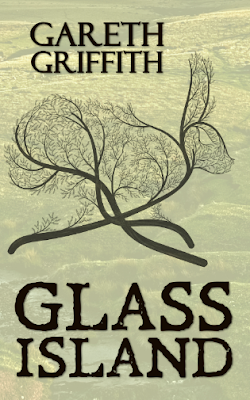 AD 576. A time of upheaval for the people of the Summer Land – the Saxons push further and further westward, a new religion supplants the old, unexpected alliances are formed and deadly rivalries fester – son against father, brother against brother.
AD 576. A time of upheaval for the people of the Summer Land – the Saxons push further and further westward, a new religion supplants the old, unexpected alliances are formed and deadly rivalries fester – son against father, brother against brother.Eleri Gwir, the daughter of a chieftain, speaks only the truth – and one thing she knows is that war is coming and that a reckoning awaits her people.The Red Cloaks of Caer Baddan, the last remnant of the Roman legions on British soil, represent hope for Eleri and for all the Summer Land. And their leader Macsen represents something else for Eleri herself – new possibilities, new horizons to explore.
As the decisive battle between the Britons and the Saxons draws nearer, Eleri and her people must decide what their role will be in this story.This rich and compelling novel brings to vivid life a moment of transformation that shaped the Britain we know today.
Amazon
Gareth Griffith
 Gareth Griffith was born in Penmaenmawr, North Wales, and now lives in Sydney, Australia with his wife Sue.
Gareth Griffith was born in Penmaenmawr, North Wales, and now lives in Sydney, Australia with his wife Sue.His career has encompassed teaching, research and writing, including many years working as the manager of research for the parliament of New South Wales. He has a PhD from the University of Wales. His academic publications include a study of George Bernard Shaw's politics, published by Routledge, and several publications on the study of parliament.
These days, when Gareth isn’t writing, he enjoys reading, music, dark Scandi film and TV, and Dark Age Britain. Glass Island is his first novel.
Gareth loves to hear from readers, you can find him: Website Twitter<!-- /* Font Definitions */ @font-face {font-family:"MS 明朝"; mso-font-charset:78; mso-generic-font-family:auto; mso-font-pitch:variable; mso-font-signature:-536870145 1791491579 18 0 131231 0;} @font-face {font-family:"Cambria Math"; panose-1:2 4 5 3 5 4 6 3 2 4; mso-font-charset:0; mso-generic-font-family:auto; mso-font-pitch:variable; mso-font-signature:-536870145 1107305727 0 0 415 0;} @font-face {font-family:Cambria; panose-1:2 4 5 3 5 4 6 3 2 4; mso-font-charset:0; mso-generic-font-family:auto; mso-font-pitch:variable; mso-font-signature:-536870145 1073743103 0 0 415 0;} /* Style Definitions */ p.MsoNormal, li.MsoNormal, div.MsoNormal {mso-style-unhide:no; mso-style-qformat:yes; mso-style-parent:""; margin:0cm; margin-bottom:.0001pt; mso-pagination:widow-orphan; font-size:12.0pt; font-family:Cambria; mso-ascii-font-family:Cambria; mso-ascii-theme-font:minor-latin; mso-fareast-font-family:"MS 明朝"; mso-fareast-theme-font:minor-fareast; mso-hansi-font-family:Cambria; mso-hansi-theme-font:minor-latin; mso-bidi-font-family:"Times New Roman"; mso-bidi-theme-font:minor-bidi;} .MsoChpDefault {mso-style-type:export-only; mso-default-props:yes; font-family:Cambria; mso-ascii-font-family:Cambria; mso-ascii-theme-font:minor-latin; mso-fareast-font-family:"MS 明朝"; mso-fareast-theme-font:minor-fareast; mso-hansi-font-family:Cambria; mso-hansi-theme-font:minor-latin; mso-bidi-font-family:"Times New Roman"; mso-bidi-theme-font:minor-bidi;} @page WordSection1 {size:612.0pt 792.0pt; margin:72.0pt 90.0pt 72.0pt 90.0pt; mso-header-margin:36.0pt; mso-footer-margin:36.0pt; mso-paper-source:0;} div.WordSection1 {page:WordSection1;} </style> --><style><!-- /* Font Definitions */ @font-face {font-family:"MS 明朝"; mso-font-charset:78; mso-generic-font-family:auto; mso-font-pitch:variable; mso-font-signature:-536870145 1791491579 18 0 131231 0;} @font-face {font-family:"Cambria Math"; panose-1:2 4 5 3 5 4 6 3 2 4; mso-font-charset:0; mso-generic-font-family:auto; mso-font-pitch:variable; mso-font-signature:-536870145 1107305727 0 0 415 0;} @font-face {font-family:Cambria; panose-1:2 4 5 3 5 4 6 3 2 4; mso-font-charset:0; mso-generic-font-family:auto; mso-font-pitch:variable; mso-font-signature:-536870145 1073743103 0 0 415 0;} /* Style Definitions */ p.MsoNormal, li.MsoNormal, div.MsoNormal {mso-style-unhide:no; mso-style-qformat:yes; mso-style-parent:""; margin:0cm; margin-bottom:.0001pt; mso-pagination:widow-orphan; font-size:12.0pt; font-family:Cambria; mso-ascii-font-family:Cambria; mso-ascii-theme-font:minor-latin; mso-fareast-font-family:"MS 明朝"; mso-fareast-theme-font:minor-fareast; mso-hansi-font-family:Cambria; mso-hansi-theme-font:minor-latin; mso-bidi-font-family:"Times New Roman"; mso-bidi-theme-font:minor-bidi;} .MsoChpDefault {mso-style-type:export-only; mso-default-props:yes; font-family:Cambria; mso-ascii-font-family:Cambria; mso-ascii-theme-font:minor-latin; mso-fareast-font-family:"MS 明朝"; mso-fareast-theme-font:minor-fareast; mso-hansi-font-family:Cambria; mso-hansi-theme-font:minor-latin; mso-bidi-font-family:"Times New Roman"; mso-bidi-theme-font:minor-bidi;} @page WordSection1 {size:612.0pt 792.0pt; margin:72.0pt 90.0pt 72.0pt 90.0pt; mso-header-margin:36.0pt; mso-footer-margin:36.0pt; mso-paper-source:0;} div.WordSection1 {page:WordSection1;} </style>-->
Published on July 18, 2018 23:00
July 17, 2018
Author’s Inspiration ~ Wendy Vella #amwriting #Regency #Romance @wendy_vella
Disappearing Down The Research Rabbit HoleBy Wendy Vella
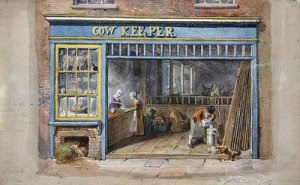
Thanks so much Mary Anne for inviting me to be part of your wonderful community here on Myths, Legends, Books & Coffee Pots. A person can get lost in here reading all those amazing posts!
When I started writing it was a simple choice for me to write both Regency and Romance as I’d already had a love of both for years. I read my first Regency at 10 years of age, Georgette Heyer ‘These Old Shades,’ and I was smitten from the first page. I love the secrets and nuances, the scandals and dramas. It was a time that lent itself to romance and intrigue. I’ve never experienced it first hand, nor has anyone else alive today; therefore, you get a certain amount of licence when you write about that time. I always make sure that any events or characters I use are accurate. However you can build a world that is as big or small as your imagination allows. Imagine a ballroom filled with hundreds of elegantly dressed people all talking and dancing, their objective to see or be seen, or a dawn appointment with two terrified men walking onto a mist shrouded field unsure if they will leave alive.
Society had rules of etiquette for pretty much everything and I would have been disgraced and hounded out of London at my first ball for breaking at least a dozen of them! Can you imagine trying to remember to let men walk up the stairs before you and never wear pearls in the morning? If a lady took off her hat she was supposed to hold it so people couldn’t see the lining as this was unseemly.
Of course the Regency Era was also a time of great change in the United Kingdom. The Prince Regent, who ruled when his father was declared unfit, and his peers were excessive in their decadent behaviour, a direct contrast to the poor who struggled to find enough food to eat. Some even feared there would be an uprising along the same lines as the French Revolution.
There was so much fuel for writing during this time and before starting book 3 in my Regency Rakes series, Tempting Miss Allender. I spent a lot of time researching facts that I thought I would need.
Patience, my heroine, was thrust into the roll of head of her family after the deaths of her parents, and does not take kindly to an old family friend trying to wrest control from her hands. Even if it is the man who was her first love!
She has two loves in her life, (that is until she realizes she still loves, Mathew) her siblings and her animals, and it was the latter that had me spending ours researching. I wanted to find a shop in London for a scene in my book, somewhere Patience could go to get supplies for the salves she makes for her animals when injured. But where I actually ended up putting her was in a Cow Keepers Shop.
The shop was in Golden Lane, not far from St Pauls Cathedral, and when I stumbled across it I was instantly enthralled. The cows were actually kept underneath the family’s accommodations, in well-ventilated stalls. Customers and milk-maids would come to the side window to purchase their fresh milk. Gives an entire new meaning to the phrase, ‘fresh to you daily’! Eggs and cheese were sold there, and a thirsty person could wander up and get a cup of lovely, creamy milk if they wanted. Could you imagine the regulations they’d be breaking if they tried that today?
Tempting Miss Allender(Regency Rakes Book 3)

Seven years after her disastrous debut, Miss Patience Allender has reluctantly returned to society to chaperone her sister. No longer the meek, mild Miss, she will never again allow a man to humiliate her. However, Patience’s resolve is severely tested when she comes face-to-face, with the very man who shattered her heart. Desperate for help when her family is thrust into danger, he is the only one she can turn to - but can she do so and keep her heart whole or will he destroy her once again?
Excerpt
His eyes fell on the cowkeeper’s shop, and he saw Charlie’s head through the window. “How about a nice warm cup of milk before we attend our appointment?” Mathew asked his brother in law.“What?” Simon looked at the shop and shuddered. “Absolutely not. I hate warm milk unless it has whisky in it.”“It’ll help you grow into a big strong man,” Mathew said as he entered the shop seconds later. “Good day to you, Charlie.” The other footman was standing at his back. He was big too, like the other one Mathew had just seen driving the carriage, and was standing close to the young Lord Allender, almost as if protecting him. Mathew wondered from what.“Oh, now it makes sense,” he heard Simon say from behind him. “Where is she?”“Are you here for warm milk also, Mathew?” Charlie was cradling a cup in his hands.“It wasn’t my intention, but now that you’ve mentioned it, it does sound like a good idea. What do you say, Simon?”“Not if it was a gold-lined cup,” Simon muttered, coming forward. “Hello, Charlie,” he greeted the boy. “Are you here alone?”“Patience is with the cowkeeper. He is showing her his cows.” Charlie accompanied his words with a roll of his eyes, which told Mathew that he did not share his sister’s love of animals. “That way,” the boy said, pointing to a stall. “I shall keep you company, Charlie, as I too am not overly enamored with cows. We shall make Mathew go and find her.” This time it was Mathew who rolled his eyes at the look his friend gave him.Moving closer to the small stall, Mathew heard voices. “And you say it will clear the infection up, Miss Allender?”“That it will, Mr. Pody, and I shall have one of my staff get it to you today, so you can start Lisa’s treatment immediately.”She was bent over, inspecting the hoof of a cow, who he guessed was Lisa, and presented him with a lovely view of her bottom. Round curves pressed against the lavender material of her dress. This vision would do nothing for his tormented dreams.
Amazon
Wendy Vella
 Wendy Vella is a lover of all things romantic, and with a voracious appetite for reading across all genre's, she started her love for historical romance with These Old Shades by Georgette Heyer. She penned her first novel at eighteen and vows it will never make an appearance further than the closet in which it currently resides.
Wendy Vella is a lover of all things romantic, and with a voracious appetite for reading across all genre's, she started her love for historical romance with These Old Shades by Georgette Heyer. She penned her first novel at eighteen and vows it will never make an appearance further than the closet in which it currently resides. With several of her Regency historical novels reaching bestseller statues on Amazon, she has recently moved into contemporary, and Regency paranormal romance.
Wendy shares her home with her own hero of 30 years, and lives in the rural North Island of New Zealand.
Wendy loves to hear from readers, you can fine her: Website Facebook Twitter
Published on July 17, 2018 23:00
The Coffee Pot Book Club
The Coffee Pot Book Club (formally Myths, Legends, Books, and Coffee Pots) was founded in 2015. Our goal was to create a platform that would help Historical Fiction, Historical Romance and Historical
The Coffee Pot Book Club (formally Myths, Legends, Books, and Coffee Pots) was founded in 2015. Our goal was to create a platform that would help Historical Fiction, Historical Romance and Historical Fantasy authors promote their books and find that sometimes elusive audience. The Coffee Pot Book Club soon became the place for readers to meet new authors (both traditionally published and independently) and discover their fabulous books.
...more
...more
- Mary Anne Yarde's profile
- 159 followers



